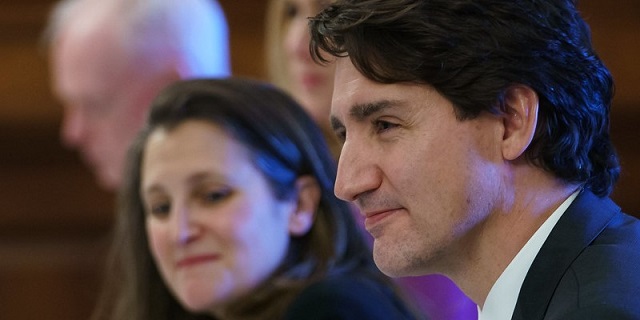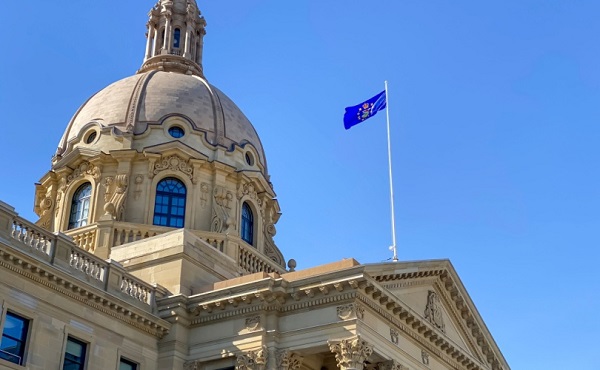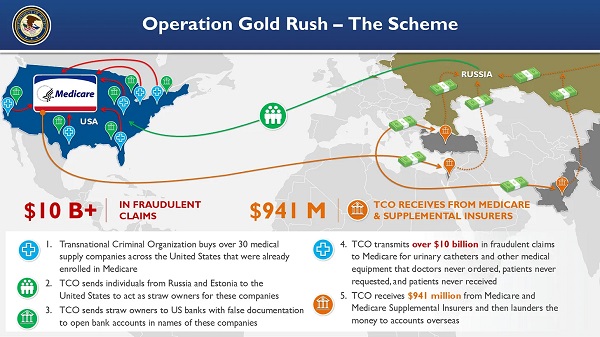Economy
Finance minister misleading Canadians about economic growth

From the Fraser Institute
By Jake Fuss and Grady Munro
Finance Minister Chrystia Freeland recently said Canada will have “the strongest economic growth in the G7.” But is that true? And are Canadians better off because of it?
The Trudeau government regularly uses comparisons among G7 countries (Canada, France, Germany, Italy, Japan, the United Kingdom and the United States) to gauge Canada’s economic performance. And when comparing economic growth in the aggregate (meaning overall growth, as measured by GDP), Minister Freeland is correct that Canada’s economy performs well compared to the rest of the G7.
Specifically, from 2000 to 2023, Canada’s average GDP growth (adjusted for inflation) was second-highest in the G7 at 1.8 per cent annually (only behind the U.S.). And in a recent report, the International Monetary Fund projected that Canada’s overall GDP growth will be second-highest in 2024, and lead the G7 in 2025.
But there’s a serious problem with these measures—they fail to account for population growth rates in each country and therefore don’t measure whether or not individuals are actually better off.
Simply put, economies grow when there are more people producing goods and services (i.e. the population grows) or when people are able to produce more per hour worked (i.e. productivity increases). In recent years, the Canadian economy has grown almost exclusively due to population growth, which has grown at historic rates due to record levels of immigration, while productivity has declined to the point it’s now considered an emergency.
In fact, from 2000 to 2023, Canada led the G7 in average annual population growth, which has served to inflate the country’s rate of aggregate GDP growth.
So, to more accurately measure Canada’s economic performance relative to other countries, economists use GDP per person, which accounts for differing population growth rates. This measure is a much better indicator of individual incomes and living standards.
On this measure, Canada is an economic laggard. Canada’s average annual growth rate in GDP per person (inflation-adjusted) from 2000 to 2023 was 0.7 per cent—tied for second-last in the G7, above only Italy (0.1 per cent).
If you include a broader subset of advanced economies, and focus on the Trudeau government’s tenure, the picture is even worse. From 2014 to 2022 (the latest year of available data), Canada was tied for the third-lowest average annual growth rate in inflation-adjusted GDP per person out of 30 countries in the Organisation for Economic Cooperation and Development (OECD). Canada’s average growth rate during that period (0.6 per cent) was only ahead of Luxembourg (0.5 per cent) and Mexico (0.4 per cent).
Looking ahead, Canada’s long-term economic prospects are similarly dismal. According to the OECD, Canada is expected to see the lowest average annual growth rate in GDP per person in the OECD, from 2020 to 2030 and 2030 to 2060.
When Minister Freeland boasts about aggregate GDP numbers—while ignoring how historic levels of population growth fuelled by record-high immigration inflate the numbers—she’s misleading Canadians. In reality, Canadian living standards are falling behind the rest of the developed world, and are expected to fall further behind in years to come.
Authors:
Automotive
Federal government should swiftly axe foolish EV mandate

From the Fraser Institute
Two recent events exemplify the fundamental irrationality that is Canada’s electric vehicle (EV) policy.
First, the Carney government re-committed to Justin Trudeau’s EV transition mandate that by 2035 all (that’s 100 per cent) of new car sales in Canada consist of “zero emission vehicles” including battery EVs, plug-in hybrid EVs and fuel-cell powered vehicles (which are virtually non-existent in today’s market). This policy has been a foolish idea since inception. The mass of car-buyers in Canada showed little desire to buy them in 2022, when the government announced the plan, and they still don’t want them.
Second, President Trump’s “Big Beautiful” budget bill has slashed taxpayer subsidies for buying new and used EVs, ended federal support for EV charging stations, and limited the ability of states to use fuel standards to force EVs onto the sales lot. Of course, Canada should not craft policy to simply match U.S. policy, but in light of policy changes south of the border Canadian policymakers would be wise to give their own EV policies a rethink.
And in this case, a rethink—that is, scrapping Ottawa’s mandate—would only benefit most Canadians. Indeed, most Canadians disapprove of the mandate; most do not want to buy EVs; most can’t afford to buy EVs (which are more expensive than traditional internal combustion vehicles and more expensive to insure and repair); and if they do manage to swing the cost of an EV, most will likely find it difficult to find public charging stations.
Also, consider this. Globally, the mining sector likely lacks the ability to keep up with the supply of metals needed to produce EVs and satisfy government mandates like we have in Canada, potentially further driving up production costs and ultimately sticker prices.
Finally, if you’re worried about losing the climate and environmental benefits of an EV transition, you should, well, not worry that much. The benefits of vehicle electrification for climate/environmental risk reduction have been oversold. In some circumstances EVs can help reduce GHG emissions—in others, they can make them worse. It depends on the fuel used to generate electricity used to charge them. And EVs have environmental negatives of their own—their fancy tires cause a lot of fine particulate pollution, one of the more harmful types of air pollution that can affect our health. And when they burst into flames (which they do with disturbing regularity) they spew toxic metals and plastics into the air with abandon.
So, to sum up in point form. Prime Minister Carney’s government has re-upped its commitment to the Trudeau-era 2035 EV mandate even while Canadians have shown for years that most don’t want to buy them. EVs don’t provide meaningful environmental benefits. They represent the worst of public policy (picking winning or losing technologies in mass markets). They are unjust (tax-robbing people who can’t afford them to subsidize those who can). And taxpayer-funded “investments” in EVs and EV-battery technology will likely be wasted in light of the diminishing U.S. market for Canadian EV tech.
If ever there was a policy so justifiably axed on its failed merits, it’s Ottawa’s EV mandate. Hopefully, the pragmatists we’ve heard much about since Carney’s election victory will acknowledge EV reality.
Economy
The stars are aligning for a new pipeline to the West Coast

From Resource Works
Mark Carney says another pipeline is “highly likely”, and that welcome news.
While attending this year’s Calgary Stampede, Prime Minister Mark Carney made it official that a new pipeline to Canada’s West Coast is “highly likely.”
While far from a guarantee, it is still great news for Canada and our energy industry. After years of projects being put on hold or cancelled, things are coming together at the perfect time for truly nation-building enterprises.
Carney’s comments at Stampede have been preceded by a number of other promising signs.
At a June meeting between Carney and the premiers in Saskatoon, Alberta Premier Danielle Smith proposed a “grand bargain” that would include a privately funded pipeline capable of moving a million barrels of oil a day, along with significant green investments.
Carney agreed with Smith’s plan, saying that Canada needed to balance economic growth with environmental responsibility.
Business and political leaders have been mostly united in calling for the federal government to speed up the building of pipelines, for economic and strategic reasons. As we know, it is very difficult to find consensus in Canada, with British Columbia Premier David Eby still reluctant to commit to another pipeline on the coast of the province.
Alberta has been actively encouraging support from the private sector to fund a new pipeline that would fulfil the goals of the Northern Gateway project, a pipeline proposed in 2008 but snuffed out by a hail of regulations under former Prime Minister Justin Trudeau.
We are in a new era, however, and we at Resource Works remarked that last month’s G7 meeting in Kananaskis could prove to be a pivotal moment in the history of Canadian energy. An Ipsos poll found that Canada was the most favoured nation for supplying oil in the G7, and our potential as an energy superpower has never been more important for the democratic world, given the instability caused by Russia and other autocratic energy powers.
Because of this shifting, uncertain global climate, Canadian oil and gas are more attractive than ever, and diversifying our exports beyond the United States has become a necessity in the wake of Donald Trump’s regime of tariffs on Canada and other friendly countries.
It has jolted Canadian political leaders into action, and the premiers are all on board with strengthening our economic independence and trade diversification, even if not all agree on what that should look like.
Two premiers who have found common ground are Danielle Smith and Ontario Premier Doug Ford. After meeting at Stampede, the pair signed two memorandums of understanding to collaborate on studying an energy corridor and other infrastructure to boost interprovincial trade. This included the possibility of an eastward-bound pipeline to Ontario ports for shipping abroad.
Ford explicitly said that “the days of relying on the United States 100 percent, those days are over.” That’s in line with Alberta’s push for new pipeline routes, especially to northwestern B.C., which are supported by Smith’s government.
On June 10, Resource Works founder and CEO Stewart Muir wrote that Canadian energy projects are a daunting endeavour, akin to a complicated jigsaw puzzle, but that getting discouraged by the complexity causes us to lose sight of the picture itself. He asserted that Canadians have to accept that messiness, not avoid it.
Prime Minister Carney has suggested he will make adjustments to existing regulations and controversial legislation like Bill C-69 and the emissions cap, all of which have slowed the development of new energy infrastructure.
This moment of alignment between Ottawa, the provinces, and other stakeholders cannot be wasted. The stars are aligning, and it will be a tragedy if we cannot take a great step into the future of our country.
-

 Alberta2 days ago
Alberta2 days agoCOWBOY UP! Pierre Poilievre Promises to Fight for Oil and Gas, a Stronger Military and the Interests of Western Canada
-

 Crime1 day ago
Crime1 day ago“This is a total fucking disaster”
-

 International2 days ago
International2 days agoChicago suburb purchases childhood home of Pope Leo XIV
-

 Fraser Institute1 day ago
Fraser Institute1 day agoBefore Trudeau average annual immigration was 617,800. Under Trudeau number skyrocketted to 1.4 million annually
-

 MAiD1 day ago
MAiD1 day agoCanada’s euthanasia regime is already killing the disabled. It’s about to get worse
-

 Daily Caller2 days ago
Daily Caller2 days agoBlackouts Coming If America Continues With Biden-Era Green Frenzy, Trump Admin Warns
-

 Daily Caller2 days ago
Daily Caller2 days ago‘I Know How These People Operate’: Fmr CIA Officer Calls BS On FBI’s New Epstein Intel
-

 Business1 day ago
Business1 day agoPrime minister can make good on campaign promise by reforming Canada Health Act







